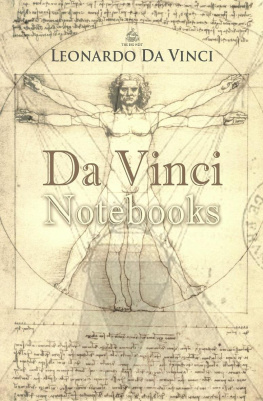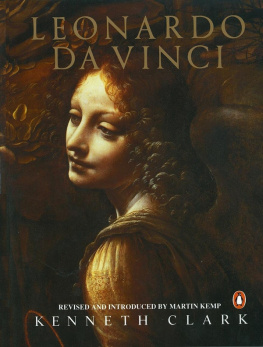Kelley - Who Was Leonardo da Vinci?
Here you can read online Kelley - Who Was Leonardo da Vinci? full text of the book (entire story) in english for free. Download pdf and epub, get meaning, cover and reviews about this ebook. year: 2005, publisher: Penguin Group US, genre: Non-fiction. Description of the work, (preface) as well as reviews are available. Best literature library LitArk.com created for fans of good reading and offers a wide selection of genres:
Romance novel
Science fiction
Adventure
Detective
Science
History
Home and family
Prose
Art
Politics
Computer
Non-fiction
Religion
Business
Children
Humor
Choose a favorite category and find really read worthwhile books. Enjoy immersion in the world of imagination, feel the emotions of the characters or learn something new for yourself, make an fascinating discovery.
- Book:Who Was Leonardo da Vinci?
- Author:
- Publisher:Penguin Group US
- Genre:
- Year:2005
- Rating:3 / 5
- Favourites:Add to favourites
- Your mark:
- 60
- 1
- 2
- 3
- 4
- 5
Who Was Leonardo da Vinci?: summary, description and annotation
We offer to read an annotation, description, summary or preface (depends on what the author of the book "Who Was Leonardo da Vinci?" wrote himself). If you haven't found the necessary information about the book — write in the comments, we will try to find it.
Who Was Leonardo da Vinci? — read online for free the complete book (whole text) full work
Below is the text of the book, divided by pages. System saving the place of the last page read, allows you to conveniently read the book "Who Was Leonardo da Vinci?" online for free, without having to search again every time where you left off. Put a bookmark, and you can go to the page where you finished reading at any time.
Font size:
Interval:
Bookmark:

By Roberta Edwards
Illustrated by True Kelley
Grosset & Dunlap
For Tanni TytelR.E.
For Eloise and Charlotte LindblomT.K.
GROSSET & DUNLAP
Published by the Penguin Group
Penguin Group (USA) Inc., 375 Hudson Street, New York, New York 10014, U.S.A.
Penguin Group (Canada), 10 Alcorn Avenue, Toronto, Ontario, Canada M4V 3B2
(a division of Pearson Penguin Canada Inc.)
Penguin Books Ltd, 80 Strand, London WC2R 0RL, England
Penguin Ireland, 25 St Stephens Green, Dublin 2, Ireland (a division of Penguin Books Ltd)
Penguin Group (Australia), 250 Camberwell Road, Camberwell, Victoria 3124, Australia (a division of Pearson Australia Group Pty Ltd)
Penguin Books India Pvt Ltd, 11 Community Centre, Panchsheel Park, New Delhi110 017, India
Penguin Group (NZ), Cnr Airborne and Rosedale Roads, Albany, Auckland 1310, New Zealand (a division of Pearson New Zealand Ltd)
Penguin Books (South Africa) (Pty) Ltd, 24 Sturdee Avenue, Rosebank, Johannesburg 2196, South Africa
Penguin Books Ltd, Registered Offices: 80 Strand, London WC2R 0RL, England
The scanning, uploading, and distribution of this book via the Internet or via any other means without the permission of the publisher is illegal and punishable by law. Please purchase only electronic editions and do not participate in or encourage electronic piracy of copyrighted materials. Your support of the authors rights is appreciated.
Text copyright 2005 by Grosset & Dunlap.
Illustrations copyright 2005 by True Kelley. Cover illustration copyright 2005 by Nancy Harrison. All rights reserved. Published by Grosset & Dunlap, a division of Penguin Young Readers Group, 345 Hudson Street, New York, New York 10014. GROSSET & DUNLAP is a trademark of Penguin Group (USA) Inc. Printed in the U.S.A.
Library of Congress Cataloging-in-Publication Data is available.
ISBN: 978-1-101-63990-0 | 20 19 18 17 16 |
Leonardo da Vinci?
Some people are enormously talented and then there is Leonardo da Vinci. He lived at a time when there were many extremely talented people all around him. Even so, he stood out.

He could draw and paint better than anyone. One of his paintings, the Mona Lisa, is the most famous painting in the world. He was a scientist hoping to unlock the secrets of the natural world. He was an engineer and inventor. He designed a bicycle that would have workedthree hundred years before the first bike was actually built.

He was an excellent athlete. A fine musician. And he was handsome. (Although there are no known paintings of him, whenever people of the day described him, they always mentioned his good looks.)

I want to work miracles, he stated. Yet he often met with failure. And while he could be charming, he mistrusted almost everyone. He was a loner. He had no family of his own. For sixteen years, he didnt even have a home of his own.
By his own standards, Leonardo was a disappointment. He never reached the goals he set for himself. His greatest works were left unfinished. Nevertheless, what he did achieve in sixty-seven years still sets the standard for human excellence. It is hard to imagine someone doing better.
An Unwanted Boy

On April 15, 1452, in a tiny hill town in Italy, a baby boy was born. His father was a well-to-do businessman, Ser Piero. His mother, Caterina, was a poor young peasant girl. We dont even know her last name. Their baby was named Leonardo. Because the town he came from was called Vinci, he was known as Leonardo da Vinci. That means Leonardo from Vinci.

Leonardos parents werent married. His father was ashamed of the baby and left him with his mother. Ser Piero married another woman, someone more respectable, and started a new family. He moved nearby to the busy city of Florence. Caterina did not want to keep her baby, either. She cared for him for only a year or two. Then she, too, married someone else and began a new family.
So what was to become of little Leonardo?
Ser Pieros answer was to leave the baby with his parents. But Leonardos grandparents were oldhis grandfather was eighty-five at the time. At their age, what did they want with a toddler? Still, they took him in. They fed him, clothed him, and gave him a home. But little else. No one loved the little boy. The only person who showed interest in him was an uncle named Francesco.

Francesco was a farmer and he loved the beautiful countryside around Vinci. He would take long walks in the hills, which were covered with olive trees.

Leonardo would go with him. It was there on these walks that Leonardo grew to love the natural world. The rolling shapes of the hills. The silvery leaves of the olive trees. The flight of birds. And the soft misty sunlight.
Everywhere he went, Leonardo took a little notebook with him. He made drawings of anything that interested him. A plant. Ducks in a stream. Flowers. An insect. Some cows. Paper was very valuable, but Leonardo was lucky. Because of his fathers business, there was always a supply. It was one of the most important things Ser Piero ever gave his son.

PARCHMENT AND PAPER
PARCHMENT IS MADE FROM THE SKINS OF ANIMALS SUCH AS SHEEP, CALVES, OR GOATS. THE SKIN IS DRIED AND TREATED UNTIL IT BECOMES FLAT AND PAPERLIKE.

PARCHMENT IS MUCH STRONGER THAN PAPER. IT IS MORE EXPENSIVE, TOO. THE BEAUTIFUL PRAYER BOOKS AND BIBLES COPIED BY HAND IN THE MIDDLE AGES WERE ON PARCHMENT. PARCHMENT IS RARELY USED TODAY.

PAPER WAS FIRST MADE IN CHINA ALMOST TWO THOUSAND YEARS AGO BY USING BARK FROM THE MULBERRY TREE. (TODAY, THE FINEST PAPER IS MADE FROM CLOTH RAGS.) PAPER WAS MADE BY WETTING AND POUNDING THE MATERIAL UNTIL IT SEPARATED INTO FIBERS OR STRANDS. THESE WERE THEN BROKEN DOWN INTO A LIQUIDLIKE SUBSTANCE THAT WAS POURED ONTO A MESH MOLD. AFTER THE SUBSTANCE DRAINED ON THE MOLD, IT COULD BE LIFTED OFF AS A SHEET OF PAPER. IN EUROPE, PAPER WAS INTRODUCED BY THE MOORS OF NORTHERN AFRICA. THE FIRST PAPERMAKING MILL WAS BUILT IN SPAIN AROUND 1150.
Font size:
Interval:
Bookmark:
Similar books «Who Was Leonardo da Vinci?»
Look at similar books to Who Was Leonardo da Vinci?. We have selected literature similar in name and meaning in the hope of providing readers with more options to find new, interesting, not yet read works.
Discussion, reviews of the book Who Was Leonardo da Vinci? and just readers' own opinions. Leave your comments, write what you think about the work, its meaning or the main characters. Specify what exactly you liked and what you didn't like, and why you think so.


















